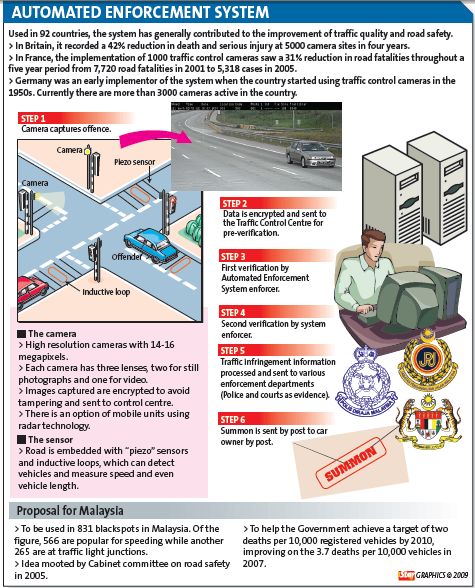Flashback: ‘Big Brother’ Is Watching Malaysia
‘Big Brother’ Is Watching Malaysia

September 26, 2009
thestar.com.my - Malaysian motorists generally follow traffic rules only when they see policemen around, but with the proposed Automated Enforcement System (AES), the enforcement officers will be watching, even if they are not on the scene. Hundreds of cameras will become the “eyes” of these policemen.
The system will transmit to a control centre photographs and videos of motorists committing traffic offences.
The centre will then issue the summonses. The unmanned cameras will be located at 831 spots around the country.
Road Transport Department director-general Datuk Solah Mat Hassan said the proposed system would help the Government lower the number of deaths per 10,000 registered vehicles to two from 3.7 in 2007. There are currently 17.971 million vehicles on the road.
Once the Cabinet gives its green light on the AES, the system could be set up in a month, although full implementation could take about two years, said a source.
“Realistically, after taking into account some government bureaucracy, it should take about four months for AES to issue its first summons,” the source said, adding that the AES was estimated to cost more than RM300mil.JPJ and other agencies had conducted a demonstration of the system in 2007 at the Guthrie Corridor and Putrajaya.
Solah told a media briefing that the AES was a “foolproof system” which used very high resolution cameras which were linked to sensors on the road.
Besides speeding, the system can detect offenders who beat the traffic lights, overtake on the left or across double lines, tailgate, drive on the emergency lane and even overload.
Presently, the police use 140 laser digital cameras, which are portable and manually operated.
“They cannot be used when it rains and they are not automatic. If three vehicles are speeding at the same time, the device can only snap one as the policeman has to aim the camera at the car.Related:
“The AES can shoot (images) of all three, it can also take photos of motorcycles. The system can also differentiate between a commercial vehicle and a private vehicle,” he said.
“We will put up signs. The AES is not to collect revenue (from summonses), but to make road users behave,” Solah said.
Implementing automated enforcement systems (AES) -- red light cameras and speeding cameras -- under the guise of traffic safety and saving lives
Automated enforcement is the use of image capture technology to monitor and/or to enforce traffic control laws. It can be used to combat aggressive driving behaviors such as speeding or running red lights. Testimony by the National Highway Traffic Safety Administration (NHTSA) administrator (Martinez, 1997) several years ago pointed out that about one-third of all crashes and two-thirds of the resulting fatalities in the United States are attributed to aggressive driving behaviors. Aggressive driving is often manifest in irresponsible driving behaviors such as speeding, running red lights, and tailgating. Increased enforcement of traffic laws is viewed as a potential solution for aggressive driving, but in reality, conventional law enforcement has not been able to keep pace with increased traffic volumes and vehicle mileage. This concern has prompted the traffic safety community and public entities in the United States and around the world to promote and use automated enforcement to improve general deterrence of aggressive driving and compliance with traffic laws; to reduce resource-intensive traditional enforcement; and to decrease high-risk enforcement methods associated with high-speed pursuits of traffic control law violators.
While there are many issues surrounding the use of automated enforcement systems (AES), including: legal (e.g., privacy, distribution of ticket revenue, ticketing procedures, legislative enactment of laws, etc.); public education and community support; and technology performance and efficiencies, the purpose of this study is to validate the effectiveness (and impact) of AES deployments which have been scientifically evaluated and documented in the research literature.
Excessive speeding, red light running, and other aggressive and high-risk driving behaviors are leading causes of crash fatalities and injuries in the United States (Retting, 1999). Traditional law enforcement alone is not enough to deter violators. The use of AES is a potentially effective way to deter high-risk driving behaviors. The goal of AES is to significantly increase the objective and perceived chances of being caught, thus creating a change in behavior that will translate into a crash reduction, whether it applies to running red lights, speeding, or other aggressive driving behaviors. While AES technology has been used in many applications, the two most common AES applications are fixed and mobile cameras for speeding, and fixed cameras at intersections for red light running violations.
Location of Intervention:
New South Wales, Australia
Charlotte, North Carolina, United States
Friesland Province, the Netherlands
Nationwide, United Kingdom
Cambridgeshire, United Kingdom
Great Britain, United Kingdom
South Wales, United Kingdom
Queensland, Australia
British Columbia, Canada
Christchurch, New Zealand
Norway
Victoria, Australia
United States:
Greensboro, North Carolina
High Point, North Carolina
Howard County, Maryland
Bucks County, Pennsylvania


